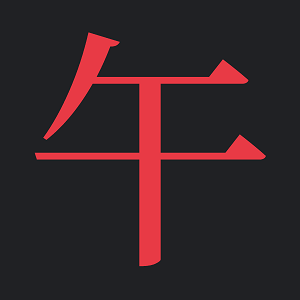午
부수: 十
획수: 4획
午 has the meanings the 7th zodiac sign, noon, day and South.

午 = 午
X = semantic
• 午 depicts a pestle standing upright.
The pestle was associated with striking the centre of a mortar and came to represent ‘centre’. For this reason, it was used to represent the central zodiac sign (the horse); the 7th zodiac sign of the Twelve Earthly Branches (地支 지지).
From the Shang dynasty, the Twelve Earthly Branches were used as a reference for time and compass directions. As the central zodiac sign, 午 is used for the two hours between 11am and 1pm. From this comes the meaning of ‘midday’ or ‘noon’.
Evolution:
午 = a pestle ➔ the 7th zodiac sign ➔ noon ➔ day
午 = a pestle ➔ the 7th zodiac sign ➔ noon ➔ South
Mnemonic
When looking at the ancient forms of 午, you can see the horizontal lines are exaggerated representations of the change in thickness of the pestle. Looking at the vertical line, imagine the downward force of the pestle as it strikes the mortar and splits the day in half. The curved feature ノ can be imagined as a hand holding the pestle 十.
Vocab
| 午年 | 오년 | Year of the Horse |
| 午日 | 오일 | the Day of the Horse |
| 端午 | 단오 | Dano (수릿날) |
| 正午 | 정오 | noon |
| 午前 | 오전 | the morning |
| 午後 | 오후 | the afternoon |
| 午餐 | 오찬 | a luncheon |
| 子午線 | 자오선 | meridian |
| 午睡 | 오수 | a midday nap |
| 午方 | 오방 | South |
Other resources
Image searches
Google
Bing
Yahoo Japan
Baidu (click 图片)
Sogou
Pinterest
Flickr
CJKV
CJKV Dict
Wikitionary
Unihan Database
Korean
Chinese
Written Chinese
Arch Chinese
ZDic
CC-Canto
Chinese Text Project
The Chinese University of Hong Kong (etymology)
Chinese Boost
Japanese
Takoboto
Jisho
JLearn.net
Sakura
The Kanji Map
Sentence Search
Immersion Kit
Vietnamese
Bibliography
Affiliate links help support uK.
— Daum 사전, [s.v. 午].
— Grant, B.K. (1982). A Guide To Korean Characters: Reading and Writing Hangul and Hanja, [s.v. 71]. Seoul: Hollym.
— Henshall, K.G. (1998). A Guide to Remembering Japanese Characters, [s.v. 110]. Singapore: Tuttle Publishing.
— Outlier Dictionary of Chinese Characters, [s.v. 午].
— Seely, C., Henshall, K.G., & Fan, J. (2016). The Complete Guide to Japanese Kanji: Remembering and Understanding the 2,136 Standard Japanese Characters, [s.v. 122]. Singapore: Tuttle Publishing.